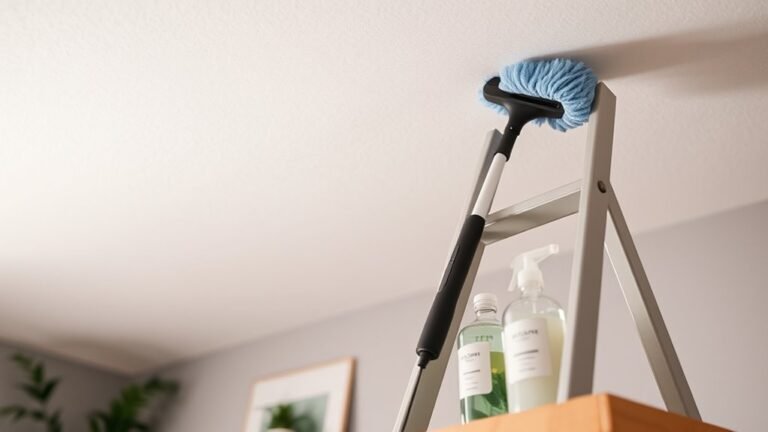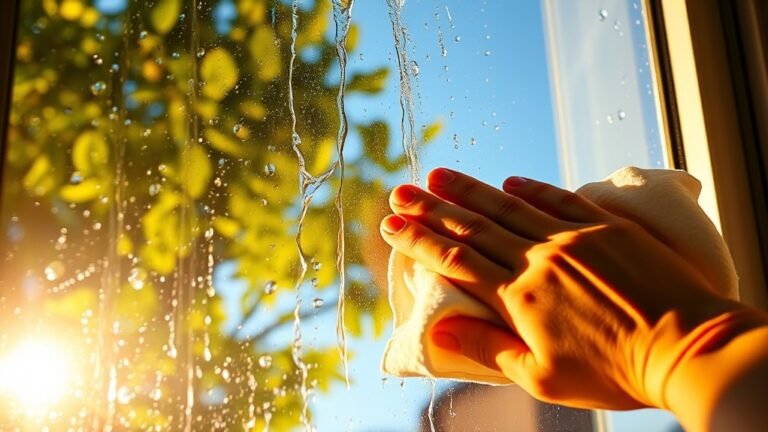How to Remove Stubborn Stains From Curtains
To remove stubborn curtain stains, first identify the stain type and your curtain’s fabric to choose the right treatment. Pre-treat grease with dish soap and baking soda, or mist wine and food stains with a vinegar-water mix. For ink, try rubbing alcohol carefully on a hidden spot first. Always blot gently, avoid rubbing, and test stain removers on inconspicuous areas. After treatment, wash curtains per care labels and air dry. Keeping these targeted strategies in mind will help you tackle even tougher spots effectively.
Identifying Different Types of Curtain Stains
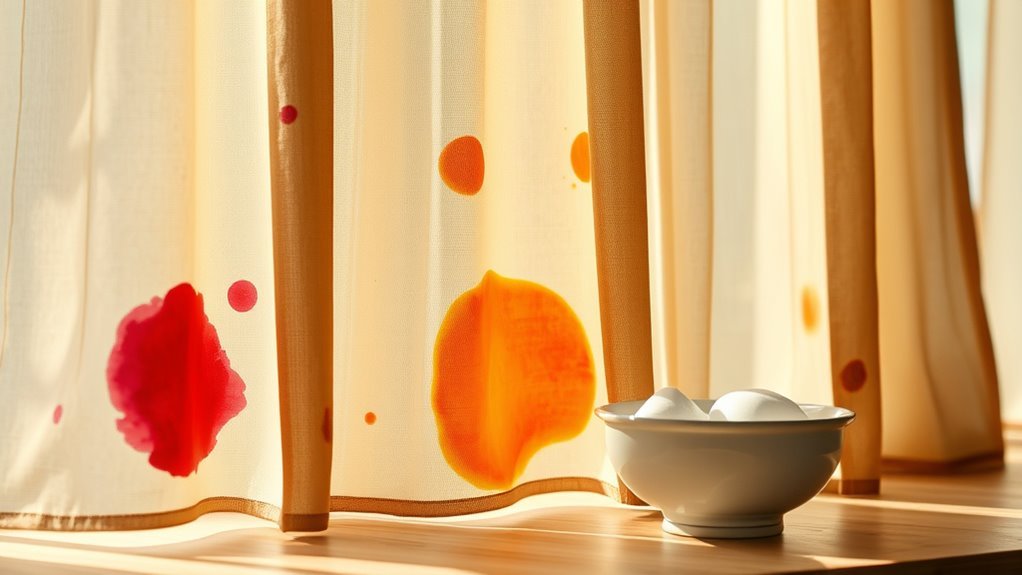
How can you effectively tackle curtain stains if you don’t know what you’re dealing with? First, identify the stain types by closely examining their characteristics. Grease stains often appear darker with a slightly shiny texture, while water-based stains like coffee or juice tend to spread irregularly and dry with a dull edge. Protein stains—think blood or sweat—usually have a crusty or flaky feel once dried. Ink or dye stains are vivid and may bleed when wet. Recognizing these stain characteristics helps you select the right cleaning agent and method, preventing damage to your curtains. Take your time to assess each mark carefully; this knowledge grants you the freedom to act decisively and restore your curtains efficiently without guesswork or trial-and-error.
Preparing Curtains for Stain Removal
Before you plunge into stain removal, there are three essential steps to prepare your curtains properly. First, identify your curtain fabric types—whether cotton, silk, polyester, or blends—since each demands specific stain treatment methods. Next, carefully inspect the stained areas under good lighting to assess severity and stain age. Finally, gather your stain treatment tools, including soft brushes, white cloths, and a spray bottle with water, ensuring you have everything within reach. Removing hardware or curtain hooks can help you handle the fabric more freely and prevent damage during cleaning. By understanding your fabric and assembling the right tools beforehand, you’ll work efficiently and avoid causing further harm, giving you the freedom to treat stubborn stains effectively and confidently.
Using Household Ingredients to Treat Stains
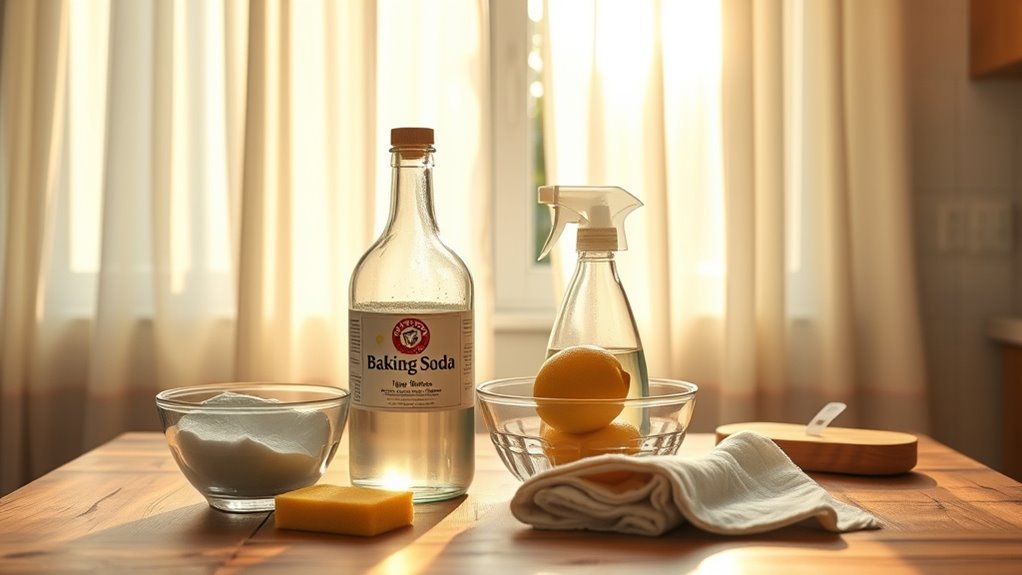
Although commercial stain removers are available, you can often tackle stubborn curtain stains effectively using common household ingredients. Start by sprinkling baking soda directly onto the damp stain to absorb moisture and loosen dirt. Let it sit for 15 minutes, then gently brush off the residue. Next, apply a vinegar solution—mix equal parts white vinegar and water—in a spray bottle. Lightly mist the stained area, allowing it to penetrate the fabric for 10 minutes. Vinegar’s acidity breaks down stain particles without harsh chemicals. Afterward, blot the area with a clean cloth to lift the stain, then rinse with cold water. Repeat if necessary, but avoid oversaturating the fabric to prevent damage. This method offers you a simple, effective way to restore your curtains using ingredients you already have at home.
Applying Commercial Stain Removers Safely
When selecting a commercial stain remover, make certain it’s compatible with your curtain’s fabric to avoid damage. Always perform a patch test on a hidden area to check for colorfastness and adverse reactions. Apply the product carefully, following label instructions, and avoid oversaturating the fabric to guarantee effective stain removal without harm.
Choosing the Right Remover
Since curtains come in various fabrics and finishes, selecting the right commercial stain remover requires careful consideration to avoid damage. You’ll want to match the remover to your curtain fabric types—delicate silks need gentle solutions, while sturdy cottons can handle stronger agents. Check product labels for compatibility with natural fibers, synthetics, or blends. When exploring stain removal techniques, opt for removers designed specifically for your curtain’s material to preserve texture and color. Avoid harsh chemicals on delicate fabrics to prevent weakening fibers or discoloration. Always choose removers that claim effectiveness on the specific stain type you’re tackling, whether oil-based or protein stains. This targeted approach guarantees you maintain your curtains’ beauty while confidently removing stubborn marks.
Patch Testing Techniques
Before applying any commercial stain remover to your curtains, you’ll want to perform a patch test to confirm the product won’t damage the fabric or cause discoloration. Start by selecting a hidden area, like the curtain’s hem or inside seam. Apply a small amount of the stain remover and wait 10–15 minutes, then gently blot with a clean cloth. Look for any color change, fabric weakening, or residue. This step confirms fabric compatibility and prevents surprises on visible sections. Always follow the product’s instructions for patch testing. If the fabric reacts poorly, try a milder solution or consult care labels for alternative methods. By prioritizing patch testing, you protect your curtains while confidently tackling stubborn stains without risking irreversible damage.
Proper Application Methods
Although commercial stain removers are designed for effectiveness, applying them incorrectly can damage your curtains or leave residues that attract more dirt. To protect your curtain fabric care, always follow label instructions and test in an inconspicuous area first. Use gentle blotting motions instead of rubbing to avoid fabric stress. Here’s a quick guide to proper application:
| Step | Action | Tip |
|---|---|---|
| 1. Preparation | Vacuum or dust curtains | Removes surface dirt |
| 2. Test | Apply remover on a hidden spot | Wait 5 minutes |
| 3. Application | Use a clean cloth to dab remover | Avoid soaking fabric |
| 4. Rinse & Dry | Blot with damp cloth, air dry | Prevent residue buildup |
Following these stain removal techniques guarantees your curtains stay fresh without compromising freedom in fabric care.
Techniques for Removing Grease and Oil Stains
When tackling grease and oil stains on your curtains, start by applying a pre-treatment solution like a gentle dish soap or a specialized stain remover to break down the oils. Choose a detergent formulated to cut through grease, and be sure to test it on a hidden area first to avoid damage. For best results, wash the curtains using warm water and a thorough agitation method, ensuring the stain is fully addressed before drying.
Pre-Treatment Solutions
Grease and oil stains can be particularly challenging to remove from curtains, but using the right pre-treatment solutions can make all the difference. When tackling these stubborn marks, you’ll want to act quickly and choose methods that respect fabric care while effectively breaking down the natural stain. Here are five expert tips for pre-treatment:
- Blot excess grease gently; avoid rubbing to prevent spreading.
- Sprinkle baking soda or cornstarch on the stain to absorb oil; leave 15 minutes.
- Apply a few drops of dish soap directly on the spot; let it sit.
- Use a soft brush to work the soap in gently without damaging fibers.
- Rinse with cold water before laundering, ensuring the stain starts to lift.
This approach frees your curtains from oily residues without harsh chemicals.
Choosing the Right Detergent
Since oil and grease stains can be deeply embedded in curtain fibers, selecting the right detergent is essential for effective removal. You’ll want to choose detergent types specifically formulated to break down oils and fats—look for those labeled as grease-fighting or heavy-duty. Enzyme-based detergents excel in targeting organic stains, boosting detergent effectiveness without harsh chemicals. Avoid detergents with added fabric softeners, as they may lock stains in. For synthetic curtains, a mild detergent with strong grease-cutting power works best, while natural fibers often benefit from gentle, plant-based detergents designed for stain removal. Always check the product’s stain-removal capabilities before purchasing. By choosing a detergent tailored to your stain type and fabric, you’ll maximize your chances of freeing your curtains from stubborn grease and oil marks.
Effective Washing Methods
There are several proven washing techniques you can use to tackle grease and oil stains on your curtains effectively. These methods not only restore your curtains’ appearance but also enhance curtain care and stain prevention. Start by treating the stain promptly to prevent setting. Then, follow these expert steps:
- Pre-treat stains with a liquid dish soap, focusing on grease-breaking properties.
- Use warm water for soaking but check fabric labels to avoid damage.
- Apply a gentle laundry detergent designed for stain removal.
- Avoid high heat drying; air dry to prevent setting residual oils.
- Repeat treatment if stains persist before a full wash cycle.
Removing Pet Stains and Odors From Curtains
Although pet stains on curtains can seem challenging, you can effectively remove both stains and odors with the right approach. Start by identifying the fabric types—delicate materials like silk require gentler treatments, while cotton or polyester can handle stronger solutions. Blot fresh stains with cold water to prevent setting. For stubborn pet odor, mix equal parts white vinegar and water in a spray bottle and lightly mist the stained area. Let it sit for 10 minutes before blotting again. Enzymatic cleaners are excellent for breaking down proteins in pet stains and neutralizing odors, especially on durable fabrics. Always test any solution on a hidden section first. With these targeted steps, you’ll regain fresh, odor-free curtains without compromising fabric integrity or your freedom to enjoy your space.
Handling Wine and Food Stains Effectively
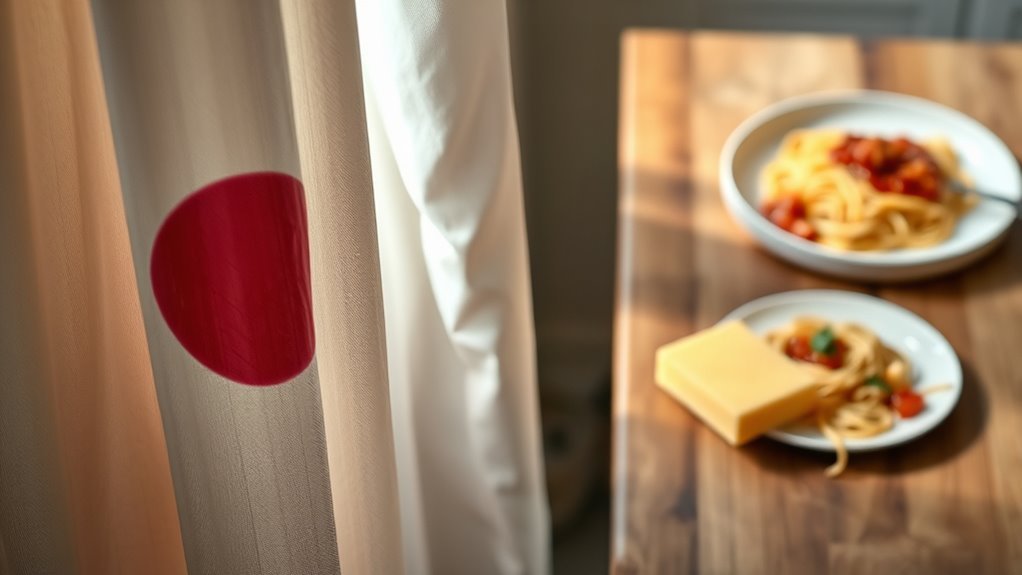
When dealing with wine and food stains on your curtains, act quickly to blot the area with a clean cloth to prevent the stain from setting. Use a cleaning agent suited for the fabric type—typically a mild detergent or a specialized stain remover designed for delicate materials. Always test the product on a small, hidden section first to guarantee it won’t damage or discolor the fabric.
Immediate Stain Treatment
Acting within the first five minutes after a wine or food stain appears on your curtains greatly improves your chances of complete removal. Quick response is key to effective stain prevention and treatment. Here’s what you should do immediately:
- Blot the stain gently with a clean, dry cloth to absorb excess liquid—don’t rub.
- Sprinkle a small amount of baking soda to lift moisture and neutralize odors.
- Use cold water to dampen the stained area, avoiding heat that sets stains.
- Avoid scrubbing, which can embed the stain deeper into fibers.
- If available, apply a mild detergent solution sparingly to break down the stain.
These precise steps empower you to tackle stubborn stains swiftly, preserving your curtains’ appearance and extending their life.
Suitable Cleaning Agents
Because different stains demand specific treatments, choosing the right cleaning agent is crucial for effectively removing wine and food stains from your curtains. Start by identifying your curtain’s fabric type—delicate silks and linens require gentler solutions, while cotton or polyester can handle stronger agents. Natural cleaners like white vinegar, baking soda, or lemon juice work wonders on many stains without damaging fibers. For wine stains, apply a mixture of equal parts water and white vinegar directly, then blot gently. For greasy food stains, sprinkle baking soda to absorb oil before treating with mild detergent. Always test any cleaner on a hidden area first to verify colorfastness. Tailoring your approach to fabric types and stains lets you restore your curtains without compromising their integrity or your freedom to enjoy a spotless home.
Dealing With Ink and Dye Stains on Fabric
Ink and dye stains can be some of the most challenging to remove from curtains, but with the right approach, you can restore your fabric effectively. Start by testing ink removal techniques on a hidden area to avoid damage. For fresh ink stains, blot gently with rubbing alcohol or a specialized ink remover. When dealing with dye transfer, act quickly to prevent permanent setting.
- Apply rubbing alcohol with a cotton swab for ink spots.
- Use a color-safe bleach or oxygen-based cleaner for dye stains.
- Avoid rubbing, which can spread the stain further.
- Rinse treated areas with cold water to halt stain setting.
- Repeat treatments carefully until the stain lifts.
These dye transfer solutions and ink removal techniques will help you regain your curtains’ original look without harsh chemicals.
Washing and Drying Curtains After Stain Treatment
Once you’ve effectively treated the stains, it’s crucial to wash and dry your curtains properly to prevent any residue or damage. First, check the care label to identify the curtain fabric and recommended washing temperature. Delicate fabrics like silk or lace require cold water and gentle cycles, while sturdier materials such as cotton or polyester can handle warmer temperatures. Use a mild detergent to protect the fabric’s integrity. Avoid overloading your washing machine; curtains need space to move freely. After washing, avoid wringing them out to prevent distortion. Instead, hang the curtains to air dry, preferably outdoors or in a well-ventilated area. If you use a dryer, choose a low-heat setting to protect the curtain fabric from shrinkage or damage. This careful approach guarantees your curtains stay clean and vibrant.
Preventative Tips to Avoid Future Curtain Stains
Proper washing and drying help keep your curtains looking their best, but preventing stains from occurring in the first place will save you time and effort. Effective curtain maintenance hinges on proactive stain prevention. You can protect your curtains by adopting simple habits that minimize exposure to dirt and spills.
- Regularly dust or vacuum curtains to reduce dirt buildup.
- Keep food and drinks away from windows to avoid accidental splashes.
- Use sheer or protective liners to shield fabric from direct sunlight and pollutants.
- Address spills immediately with a clean cloth to prevent setting stains.
- Schedule routine deep cleaning based on fabric type and room conditions.
Frequently Asked Questions
Can I Remove Stains From Curtains Without Taking Them Down?
You can definitely tackle stains without taking your curtains down by spot cleaning. First, identify your fabric type to choose the right cleaner—delicate fabrics need gentle solutions. Use a soft cloth or sponge with mild detergent and dab the stain gently; avoid rubbing to prevent damage. Test the cleaner on a hidden area first. This method saves time and keeps your curtains hanging freely while effectively removing spots.
How Do I Clean Delicate or Antique Curtains Without Damage?
You might worry delicate or antique curtains will get ruined during cleaning, but with careful fabric care, you can preserve vintage fabrics beautifully. Start by testing a small hidden area with a gentle detergent diluted in cold water. Use a soft sponge to blot stains—never rub. Avoid harsh chemicals and direct sunlight when drying; instead, air-dry flat or hang in a shaded spot. This way, you keep your curtains intact and stunning.
What Should I Do if My Curtains Shrink After Washing?
If your curtains shrink after washing, don’t panic. Start by re-wetting them with lukewarm water and gently stretching the fabric back to its original size. Use fabric restoration techniques like steaming or lightly ironing with a damp cloth to relax fibers. For future curtain care tips, always wash in cold water and avoid high heat drying. Taking these steps gives you more freedom to enjoy your curtains without worrying about damage or shrinkage.
Are Steam Cleaners Safe for Removing Curtain Stains?
Oh, sure—nothing says ‘stain removal’ like blasting your delicate curtains with a steam cleaner, right? But seriously, steam cleaner effectiveness depends on fabric compatibility; natural fibers like cotton handle steam well, but delicate silks or velvets might suffer. You’ll want to test a hidden spot first. Using a steam cleaner can free you from harsh chemicals, but always adjust temperature and pressure to avoid damage. It’s a powerful ally if you respect your curtain’s fabric.
How Often Should I Professionally Clean My Curtains?
Your cleaning frequency depends largely on your curtain’s fabric type and environment. For delicate fabrics like silk or velvet, professional cleaning every 12-18 months is ideal to maintain texture and color. Heavier fabrics, such as cotton or polyester blends, can handle annual cleanings. If you live in a dusty area or have pets, consider more frequent cleanings. Always check care labels and consult professionals for tailored advice, so your curtains stay fresh without damage.


